 |
||
|
|
|
Celebrating the pipe organ, the King of Instruments |
Pipedreams Euro-Tour
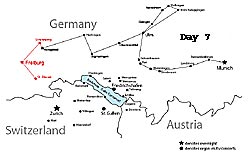 |
April 28 - May 11, 2006
Day 7 -
Schramberg, Freiburg &
Saint Blasien
 Notes from the Road - travel log, day 7
Notes from the Road - travel log, day 7 Michael Barone’s pictures from the tour
Michael Barone’s pictures from the tour Images from Saint Maria, Schramberg
Images from Saint Maria, Schramberg Images from Freiburg Minster
Images from Freiburg Minster Images from Saint Blasien
Images from Saint Blasien Day 6 - Obermarchtal & Hechingen
Day 6 - Obermarchtal & Hechingen Day 8 - Villingen, & Überlingen
Day 8 - Villingen, & Überlingen Main Tour Page
Main Tour Page
Schramberg (Saint Maria)
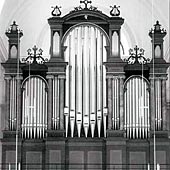 |
In 1774, a first organ has been mentioned for the Saint Nikolaus church. In 1838, it was decided to build a new church next to the existing Saint Nikolaus church. The new organ for this new church, Saint Mary, was built in 1844 by Eberhard Friedrich Walcker (Ludwigsburg) with 35 stops on three manuals and pedal and it is preserved with only minor alterations. In 1900, Walcker rebuilt the instrument: the pedal slider chests were replaced by cone chests, the key action became pneumatic and a new console had to be built, the division “Manual II” was put in a swell case, all pipes were put up for one or two halfsteps. In 1917, the original tin facade pipes were replaced by zinc pipes, except for the even pipes in the center tower.
After WWII the organ fall into decay, and temporarily, plans were underway to build a completely new organ in neo-baroque style, a common trend in those years. But fortunately, after careful examinations of the instrument, it was decided to restore the Walcker organ. The Swiss firm Kuhn Orgelbau completed these works in 1996. Most of the original pipework was preserved, several later changes could be reversed. The original cone chests of the manual divisions were preserved, the entire key and stop actions (with barker-levers) and the five bellows of the wind system have been reconstructed. The one and only stop on the third manual, Physharmonica, is located in the console - a harmonium reed stop with a wind swell system that allows different dynamics. The console has been built entirely new after original Walcker drawings.
Links and resources
 Notes from the Road - travel log, day 7
Notes from the Road - travel log, day 7 Images from Saint Maria, Schramberg
Images from Saint Maria, Schramberg Saint Maria description/website
Saint Maria description/website City of Schramberg
City of Schramberg Find detailed organ specifications in our Tour Book
Find detailed organ specifications in our Tour Book
| Return to top |
Freiburg (Saint Maria)
Freiburg is a city in Baden- Württemberg, on the western edge of the southern Black Forest (German: Schwarzwald) with about 214,000 inhabitants. Freiburg has a sunny microclimate and popular opinion has it that Freiburg is the warmest, sunniest city in Germany. It straddles the Dreisam river, among the foothills of the Schlossberg. The city is surrounded by several Black Forest mountains.
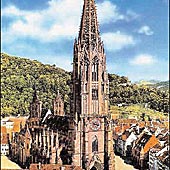 |
The minster has four organs, located in various places. They can be played separately, but also all together from a general console at the south side of the chancel.
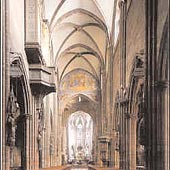 |
The Nave Organ (swallow’s nest at the north wall) was built in 1965 by the Danish company Marcussen & Son from Apenrade (II/P/21) in a neo-Baroque style with tracker actions. The case has been formed similar to the Ebert organ case from 1548. The West Gallery Organ (Saint Michael’s Gallery) was built in 1965 by Gebr. Späth from Ennetach (with II/P/28) in a case which was formerly part of the 1929 Nave Organ.
Finally, the largest of the four instruments, Saint Mary’s Organ, in the north transept, was built by the Austrian company Rieger from Schwarzach in 1965 (IV/P/62), and renovated in 2001 by Caspar Glatter-Götz and Beat Grenacher. The instrument can be played both with a mechanical action console and from the general console in the chancel. The facade mirrors the inner structure of the various divisions: In four pipe towers underneath the console, the Positiv is placed (the lowest tower), flanked by the Hauptwerk. Directly above the console is the Brustwerk, above the three towers, the Schwellwerk, and on the left side, the Pedal division.
Links and resources
 Notes from the Road - travel log, day 7
Notes from the Road - travel log, day 7 Images from Freiburg Minster
Images from Freiburg Minster Freiburg - Wikipedia
Freiburg - Wikipedia Description of City of Freiburg & the Church
Description of City of Freiburg & the Church Find detailed organ specifications in our Tour Book
Find detailed organ specifications in our Tour Book
| Return to top |
Saint Blasien (Cathedral)
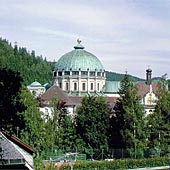 |
The first monks settled at this site as early as the middle of the ninth century, and eventually a Benedictine monastery was founded in 983. At the end of the eleventh century, a new abbey church was built, however, it was replaced by the present Baroque church in 1786 by the famous Alsacian architect, P. M. d’Ixnard, under Abbot Martin Gerbert. Along with Rot an der Rot, the abbey church of Saint Blasien is one of the largest Benedictine monumental church buildings in Southern Germany. With the appointment of a French architect, it was guaranteed that, instead of an old-fashioned Rococo architecture, the extraordinary modern style of the Early French Classicism would be applied to the new church building. Ixnard had studied in Paris, where he may have been inspired by such buildings as the church of Saint Sulpice with its columns of the west facade or by the dome of the Pantheon. The spacious interior with its large rotunda is overwhelming beautiful. Also, on the opposite side of the main entrance, another nave was added - the chancel or monk’s choir, separated by a choir screen.
In 1775, the newly-built abbey church received an organ of enormous reputation, built by the famous Johann Andreas Silbermann as his opus magnum, with 47 stops on three manuals and pedal. Its place in the gallery in the chancel dominated the view upon entering the church and it “substituted” for a High Altar, as abbot Martin Gerbert had wanted.
After the secularization of the church in 1807, the new owner of the church, the Grand Duke of Baden, gave this unique organ, along with the 12 big bells of Saint Blasien’s abbey church, to the Roman Catholic Church of Saint Stephen in Karlsruhe in 1814. The organbuilder F. Stieffell from Rastatt rebuilt the instrument and maintained the Silbermann organ until 1856. In the following decades, the firms of E. F. Walcker from Ludwigsburg and Voit & Sons from Karlsruhe rebuilt the instrument several times, replaced the slider chests with cone chests, and added several new stops. In 1944 the organ was destroyed by bombs in WWII.
 |
The present organ in the front gallery of the chancel was built in 1913 by F. W. Schwarz from Überlingen with a facade that freely adopted the old Silbermann facade from 1775. Only 47 of the front pipes sound, and the architecture of the front stands in no relation to the inner structure of the organ’s divisions. The instrument was repaired and restored several times by Welte, Späth and Klais. Still today this nearly unaltered organ has preserved its unique symphonic character, underlined by the huge cathedral-like acoustics with a reverberation of c. 10 seconds.
Links and resources
 Notes from the Road - travel log, day 7
Notes from the Road - travel log, day 7 Images from Saint Blasien
Images from Saint Blasien Exterior view of Saint Blasien
Exterior view of Saint Blasien Interior 360-degree view
Interior 360-degree view Description (in German)
Description (in German) Find detailed organ specifications in our Tour Book
Find detailed organ specifications in our Tour Book
| Return to top |


